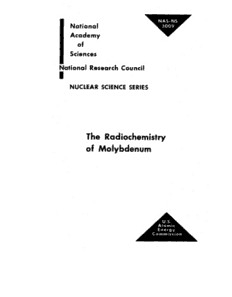
The radiochemistry of molybdenum PDF
Preview The radiochemistry of molybdenum
National Academy of Sciences National Research council s NUCLEAR SCIENCE SERIES The Radiochemistry of Molybdenum COMMITTEE ON NUCLEAR SCIENCE L.F.CURTISS,Chairman ROBLEY D.EVANS, ViceCkainna?I NationalBureauofStandards MassachusettsInstitutoefTechnology J.A.DeJUREN, Secretary WestinghouseElectricCorporation H.J.CURTIS G.G.MANOV BrookhavenNationalLaboratory Tracerlah,Inc. SAMUEL EPSTEIN W. WAYNE MEINKE CaliforniIanstitutoefTechnology Universityof Michigan HERBERT GOLDSTEIN A.H.SNELL NuclearDevelopmentCorporationof Oak RidgeNationalLaboratory America E.A.UEHLING H.J.GOMBERG UniversityofWashington UniversityofMichigan D.M. VAN PATTER E.D.KLEMA BartolResearchFoundation NorthwesternUniversity ROBERT L.PLATZMAN ArgonneNationalLaboratory LIA SON MEMBERS PAUL C.AEBERSOLD W. D.URRY AtomicEnerW Commission U.S.AirForce J.HOWARD McMILLEN WILLIAM E.WRIGHT NationalScienceFoundation OfficeofNavalResearch SUBCOMMITTEE ON RADIOCHEMISTRY W. WAYNE MEINICE,Chai?man EARL HYDE UniversityofMlchlgan UniversityofCalifornia(Berkeley) NATHAN BALLOU HAROLD KIRBY Navy RadiologicaDlefenseLaboratory Mound Laboratory GREGORY R.CHOPPIN GEORGE LEDDICOTTE FloridaStateUniver~ity Oak RidgeNationalLaboratory GEORGE A.COWAN ELLIS P.STEINBERG Los Alsmos ScientifiLcshoratory ArgonneNationalLaboratory ARTHUR W. FAIRHALL PETER C.STEVENSON UniversityofWashington UniversityofCaliforni(aLlvermore) HARMON FINSTON LEO YAFFE Brookhaven,NationalLaboratory McGillUniversity .. The Radiochernistry d Molybdenum By E. hf.SCADDEN and N. E. BALLOU U. S. Naval Radiological Defense Laboratory San Francisco, California January1960 Subcommittee on Radiochemistry NationalAcademy ofSciences—National Research Council PrintedinUSA.Price$0.S0AvaileblferomtheOfficeofTechnical ServiceeL,MparhnentofCommerce,Waehingtcm26,D.C. FOREWORD ‘IheSubcommittee on Rsdiochemistry 1s one of a number of .vubcommitteeamrkhg uoder the Committee on NuclearScience within the National Academy of Sciences-National Sesesrch Cmmcil. ItsmemberErepresentgovernment,industrial, and univer,eity laboratories in the areas of nwlear chemistry and analytical chemistry. The Subcommittee has concerned iteelf with thoseareas of nuclear science which involve the chemist, such aa the collection and distribution of radiochendcal procedures, the establishment of Specificatiu for radiochemically pure reagents, the problems of stockpiling uncontaminated materials, the availability of cyclotron time for service irradiations, the place of rsdhchem.istry in the undergraduate college program, etc. Ibis series of monographs has grown out of the need for uP_ti-*te aPilatioM of radiochsmical Info-tion and procedures. The Subcommitteehas endeavoredto presenta serieswhichwill be of maximumuse to theworking scientist and which contains the latest available information. Each umograph collects in one volume the ~rtinent information required for radiochemical work with an indi- vidual element or a group of closely related el~nts. An e~rt in the radiochsmistry of the particular element has written the nnnmgraph, following a standard format develo~d by the Subcommittee. The Atomic Energy Commission has sponsored the prtiting of the series. The Subcommittee is confident these publications will be useful not only to the rsdiochemist but also to the research worker in other fields such as physics, biochemistry or medicine who wishes to use radiochemlcal technique to solve a specific problem. W. Wayne Meinke, Chairman Subcommittee on Sadiochemistry ill CONTENTS hKt2 I. GeneralRevienaof the korgauic and Analytical.Qnx&itry of Mol.ybiemrn 1 IL Table of Isotopesof M.ybdenum 2 III. Reviewof ThoseFeatu.msof MolybdenumQu9mistryof QrLef bbrest to Radiochemist’s 2 1. k=C mo~bdenum andud-ybdenumWoxbde 2 2. SolubleCarlpoundsof molybdenum 3 3. Insolublecaqmnde of mol@denum 4 49 &mpla ions of mol@denlml 8 59 Chelatecampoundaof molybdenum 9 6. SolventExtractionof molybdenum II 7. Chrcuuatographibcehaviorof molybdenum 16 e. Electrochemicalbehaviorof molybdenum 20 Iv. Dissolutionof saraplas for RadioactiveMolykdemm Deterniinatione 21 v. kunting Techniquesfor RadioactiveMolybdenum 21 VI. Collectionof Dait.ailaRdadiochemicalProceduresfor k?mlybdenum 22 v DNTRODLICTK$N ~is volume which deals with the radiochemistry of molybdenum ia one of a series of monographs on radiochemiatry of the elementm. ‘l’hereis included a review of the nuclear and chemical featuree of pertucuhr in-rest ta the radiochemist, a discussion of problem of dieaolution of a sample and counting techniques, and finally, a collection of radiochemical Proced-s for the elemnta as found in the literature. ’17mseries of monograph will cover all elements for which radiochemical procedures are pertinent. Plane include re- vision of the monograph periodically a6 new techniques and pro- cedures warrant. !l’hereader is therefore encouraged to call to the attention of the author any published or unpublished material on the radlochemimtry of molybdenum which might be included in a revised version of the monograph. T-i I. GENEFbURXVIEW ~ THE INCEGANICAND ANAUTICAL m?JmTRY m mLYmENuM WA (huprehensiveTreatiseon tigani c and TheoretAcsl~t&, J. W Mella, Vol. XI, Chapter~ Lqgnane, Green and b., NewYork (1931) “Ansl@cal &amistIT of the ManhatlxinProjeot”,G J. Redden and J. C.W@?, pp. 4x-455, M&rawHill Book b., k York (1950) ~AppliedInorgauic AIIS&SiSn, IHllebrand, MdeKl, -t and Hof- 2nd e&, “MolyMero.Y@, pp. 302-316, John Wihy and SODS, hce, NewYork (1953) wFtits Epbrdm Iuorgadc &mist&, P. C. ~ ThorneandE. R. ltdsrts~ QM@= m, 6th d, rev.,Nor&man Publishingb., Ino..,k York (1954) %fnelintsHandbucbder AnorganiscbenChemi#, Sys* No. 53~ W e&~ Verlag Qusmle,G.M.B.H.Berlin(1935) IIMOI.@&~ QYMPOWW, D. H. Klllefferand A. ldns, h’te.rsdenosPuliMshersO NewyOrk (1952)- - Wutlbes of Methodsof Qmmical kalysis”~ Go.EoFoLurdeH.ad J.I. Hoffmsrq JohnWiley and Sons, hlC., New york (1938) WiusldtativsAnalysisfor theF&e Elements”,A.A. Noyes and W.c.Bray, The h~ b., New York (1948) PreferenceBook of Inorganic-sW, W.lL Lather and JX. HildebraQ 3rd cd.,The Mami.llanb., NewYork (1951) ‘Scdtts StandardNst.lmdsof C&micsl Ansl@sn, N.H. Fumau~ Editor, 5th ed.,Vol. I, KNoI@denuu?’,pp. 585-613,D. Van Nosixamik., hlC., NewYork (1939 ) lf~atim on Imrgauic -SW’s H. -, Vol. llPElsevierPuld&hing ~., New York (1956) 1 Isotope Ealf lffe Type Of Method d FTeptim Wcav lip 5.7 br 19-i%(p,-)Mow Mo91m 66 aec M& (7,n)B&h 91 M091 15.5min Mow (7,n)MO Mo* (n,2n)ktc#l 6.95br IT lTb93(d,2n)Mo93m ITb93(p~n)M093n >2 ~ am a k@* 66.0hr 14.6ndn P-, 7 fiaaIm 11.5mln P- a2min P- fiesion See “’lhbleof Ieotopes”by D. S~ r, J. Hollader and G. -berg, . Reviewe of Modem PhyeicBx$ Ho. 2S Part 112April 1958for mre infm- tion concerningdecay echems, daughterproductejetc. and for mfemnces to tbe Ortginallitemtllm. III. REVIEWSOF mm FEATURE m MoImDElm! CHEMISTRYOF CHIEF IN-T ~ RADICCEWIS!tS 1. Metillic idol.y%iem.aawnd Molybdenum Tricdde liolyWlenumIB a hanl mtal; -y In powder fomn and silveryin appar- ance h conqactfm It has a deneltyof 10.2ani itsmlting point la about 2620%. ‘he potential(E@ for theMeblo(VI)coupleie + 1.05volte.1 Metialsof p~p~tion of themetal includereductionof mol.ykdenuntrioxlde with hydrcgen or carbon or reduction of ammnium molykdate with hydrogen. Saface oxidation of the m3til prcceeds slarly at room tempexwatm. !lhenKItalia soluble h diluta nitric acid, ~ aq= regia or hot ccm- cent~~ euMurlc acId. Ccmcentm3tad nitric acid mnde= the metil passive. 2
